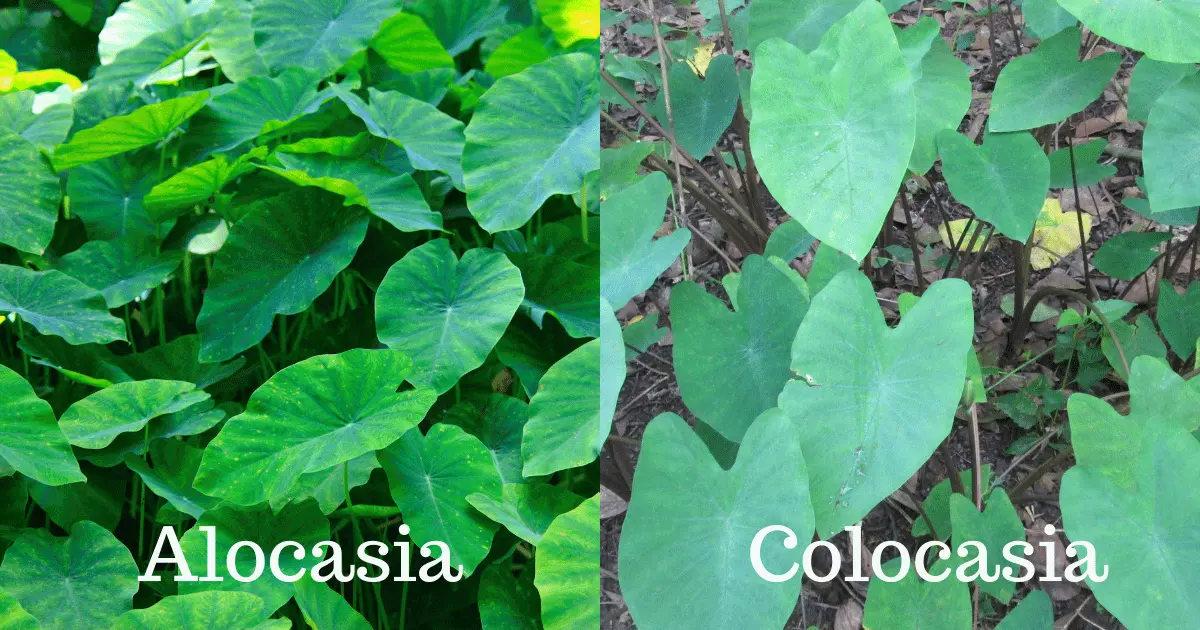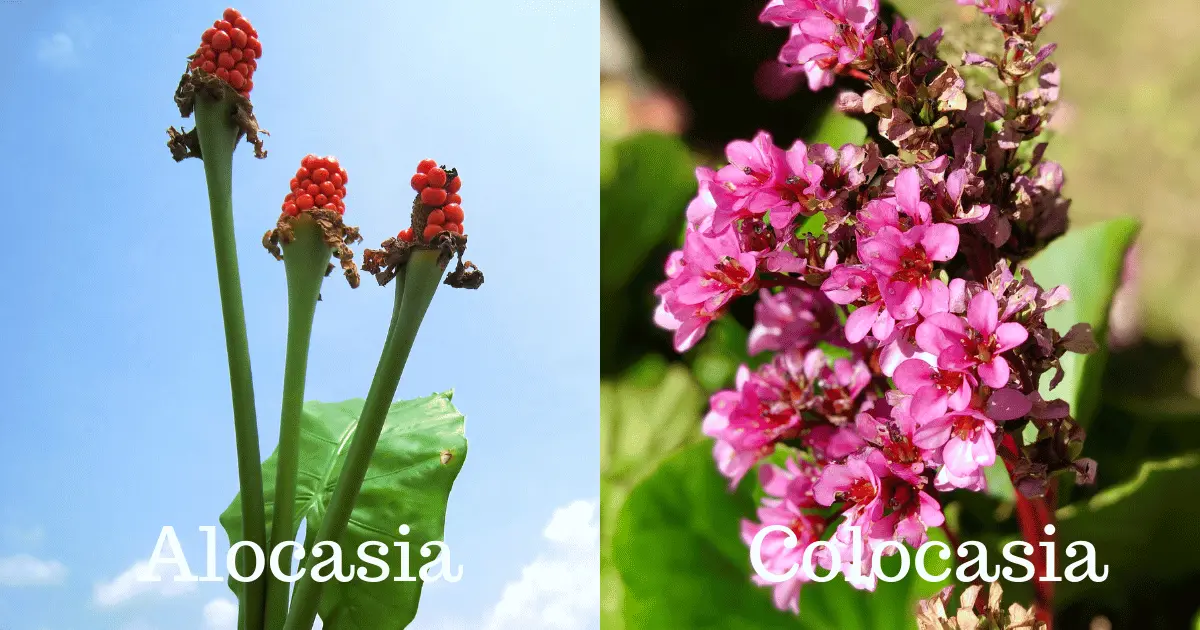Alocasia and Colocasia plants are often confused with each other due to their similar looks. They are both popular in horticulture mainly because they are easy to take care of and look extravagant. Not only do they share similar features, but they also share a nickname called ‘Elephant ears”.
Alocasia vs Colocasia

Alocasia (Alocasia spp) is a famous houseplant mostly used as a decorative plant. It was originally found in Asia and Eastern Australia, and the genus has 97 species. Alocasia is a fast-growing plant that can sometimes cause problems because it may become invasive.
Alocasia is among the oldest food crops in Oceania, where at one time, it was a staple food. The plants have a horizontal direction, and the petioles are elongated into the leaves, which is why the leaf tips point upwards. The spear-like appearance of the leaf laminae and petioles easily recognizes alocasia.
Colocasia (Colocasia, Alocasia Xanthosoma spp) is a tropical plant known as Elephant Ear or Taro. They are native to Southeastern Asia and India and are selected for their ornamental characteristics. Colocasia is primarily used for ornamental purposes, and they bring jungle vibes into any room and garden.
The best part of the Colocasia plant is that you can eat its tubers, the same way you’d eat potatoes because they are used as food. Colocasia plants are tuberous and are known to be used in some traditional Asian cuisine.
Though all parts of the plants are poisonous while raw, the tubers are edible once cooked. The plant can be used as a houseplant/ interiorscape or as a cultivated, tender, or hardy bulb in the landscape.
Comparison Table
Detailed information about Alocasia and Colocasia is presented in the table below;
| Alocasia | Colocasia | |
| Common name | Alocasia, Elephant ear | Elephant ear, taro, coco yam |
| Botanical name | Alocasia spp | Colocasia, Alocasia, Xanthosoma spp |
| Family | Araceae or Aroid | Araceae |
| Plant type | Herbaceous, perennial | Tropical, perennial |
| Mature size | 2-15 ft tall 2-8 ft spread (Depends on species and varieties) | 3-8 ft tall, Similar spread, Similar in colder climates |
| Sun exposure | Bright indirect light indoors Partial shade outdoors | Full sun to partial shade |
| Soil type | Loose, well-draining potting mix or crumbly loam soil | Moist |
| Soil pH | Slightly acidic (5.5 to 6.5 pH) | Acidic (5.5 to 7.0) pH |
| Bloom time | Spring and summer | Late spring to early fall (Rarely flowers) |
| Flower color | Light butter yellow (Flowers are not showy) | Yellowish-white |
| Hardiness zones | 10-11 (USDA) | 8-11 (USDA) |
| Native area | Tropical and subtropical regions of Asia, Eastern Australia | Asia, Australia, Central America, South America, and Africa |
| Toxicity | Toxic to dogs, cats, and humans | Toxic to pests and humans (Tubers not included) |
Leaves
Both plants have very large leaves and are sometimes called Elephant ears. The leaves of alocasia are upward-facing and standing up horizontally. On the other hand, colocasia leaves tend to point downward.
The leaf shape is an arrowhead, although it can also be heart-shaped. They also appear green and glossy, with distinctive veins on the underside. Colocasia plants have petioles that extend down from the notch into the leaves.
This is why the leaves appear to be dropping downwards. Colocasia also has a matte dark green color without any prominent veins and differs in shape.
Petioles
The petiole is the stem that attaches the leaf to the plant’s main stem. The petioles of the alocasia extend into the leaves, while the petiole of the Colocasia connects down from the notches in the leaves.
Tubers

Alocasia and colocasia do not grow from seeds; instead, they grow from a small tuber or bulb. Alocasia tubers are smaller, thin, and plain without prominent stripes or eyes.
In contrast, colocasia tubers are large, smaller, and encircled by striped bands. Colocasia tubers are also known as taro and are used for food in Hawaii.
Height
Unlike Colocasia, Alocasia varieties are smaller, and their average height is between two to six feet. In contrast, colocasia varieties grow between three to ten feet but are best known to vary in size from 8 inches to over nine feet.
Roots and flowers

Even though these plants look the same, the structure of their roots differs. Alocasia grows thinner tubers together with rhizomes.
In comparison, colocasia produces only large tubers that can be used as a food crop. When propagating, ensure you separate the tubers from the rhizomes in alocasia, while only tubers should be separated and used for propagation in colocasia.
Growing Requirements and Care
While they are members of the same family, they do not have the same growing requirements.
Soil
Alocasia doesn’t prefer moist soil as it can lead to root rot, which can affect the plant’s overall health. For this reason, it would be best to plant alocasia in well-draining soil that doesn’t retain moisture.
For colocasia, the plant grows best in rich, humusy moist soil to the point of being wet. The plant is best for boggy areas, marshes, swampland, or water gardens.
Light
Alocasia prefers slightly shaded areas, while colocasia can be grown in full sun exposure. Colocasia can survive in 6 inches of standing water, although it is best to plant when the soil is wet and not soggy.
Water
Both plants should be kept moist all year because they are water-loving plants. However, they require less water during winter because the plant is dormant.
For a good watering guide, allow the soil’s top few inches to dry before watering. This will help to keep the soil evenly moist, as soggy soil makes the plant susceptible to fungal infections.
Temperature and Humidity
Alocasia plants will die on a temperature that’s below 60 degrees Fahrenheit. They require and thrive best in humid environments. For the best humidity, place it on a tray filled with pebbles and then add water until the temperature rises to just below the bottom of the pot.
Colocasia plant thrives in humidity, needing moisture constantly. They will be evergreen in USDA zone 10 or slightly warmer temperatures.
Fertilizer
Alocasia plants are heavy feeders, so the plant should be fed with liquid fertilizer once or twice a month with a 20-20-20 formulation during the growing season.
